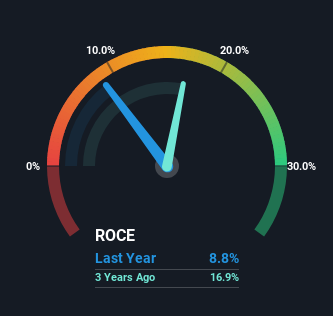Hubify (ASX:HFY) May Have Issues Allocating Its Capital
If we want to find a potential multi-bagger, often there are underlying trends that can provide clues. In a perfect world, we'd like to see a company investing more capital into its business and ideally the returns earned from that capital are also increasing. Put simply, these types of businesses are compounding machines, meaning they are continually reinvesting their earnings at ever-higher rates of return. Having said that, from a first glance at Hubify (ASX:HFY) we aren't jumping out of our chairs at how returns are trending, but let's have a deeper look.
Return On Capital Employed (ROCE): What Is It?
For those who don't know, ROCE is a measure of a company's yearly pre-tax profit (its return), relative to the capital employed in the business. Analysts use this formula to calculate it for Hubify:
Return on Capital Employed = Earnings Before Interest and Tax (EBIT) ÷ (Total Assets - Current Liabilities)
0.088 = AU$1.3m ÷ (AU$20m - AU$5.3m) (Based on the trailing twelve months to June 2023).
Therefore, Hubify has an ROCE of 8.8%. On its own, that's a low figure but it's around the 8.3% average generated by the Telecom industry.
Check out our latest analysis for Hubify

Historical performance is a great place to start when researching a stock so above you can see the gauge for Hubify's ROCE against it's prior returns. If you want to delve into the historical earnings, revenue and cash flow of Hubify, check out these free graphs here.
What Can We Tell From Hubify's ROCE Trend?
On the surface, the trend of ROCE at Hubify doesn't inspire confidence. Around four years ago the returns on capital were 43%, but since then they've fallen to 8.8%. However it looks like Hubify might be reinvesting for long term growth because while capital employed has increased, the company's sales haven't changed much in the last 12 months. It's worth keeping an eye on the company's earnings from here on to see if these investments do end up contributing to the bottom line.
On a related note, Hubify has decreased its current liabilities to 26% of total assets. That could partly explain why the ROCE has dropped. What's more, this can reduce some aspects of risk to the business because now the company's suppliers or short-term creditors are funding less of its operations. Some would claim this reduces the business' efficiency at generating ROCE since it is now funding more of the operations with its own money.
In Conclusion...
In summary, Hubify is reinvesting funds back into the business for growth but unfortunately it looks like sales haven't increased much just yet. It seems that investors have little hope of these trends getting any better and that may have partly contributed to the stock collapsing 77% in the last three years. In any case, the stock doesn't have these traits of a multi-bagger discussed above, so if that's what you're looking for, we think you'd have more luck elsewhere.
Hubify does have some risks though, and we've spotted 3 warning signs for Hubify that you might be interested in.
While Hubify may not currently earn the highest returns, we've compiled a list of companies that currently earn more than 25% return on equity. Check out this free list here.
Valuation is complex, but we're here to simplify it.
Discover if Hubify might be undervalued or overvalued with our detailed analysis, featuring fair value estimates, potential risks, dividends, insider trades, and its financial condition.
Access Free AnalysisHave feedback on this article? Concerned about the content? Get in touch with us directly. Alternatively, email editorial-team (at) simplywallst.com.
This article by Simply Wall St is general in nature. We provide commentary based on historical data and analyst forecasts only using an unbiased methodology and our articles are not intended to be financial advice. It does not constitute a recommendation to buy or sell any stock, and does not take account of your objectives, or your financial situation. We aim to bring you long-term focused analysis driven by fundamental data. Note that our analysis may not factor in the latest price-sensitive company announcements or qualitative material. Simply Wall St has no position in any stocks mentioned.
About ASX:HFY
Hubify
Engages in the sale, customization, and integration of IT and telecommunications systems in Australia.
Flawless balance sheet with low risk.
Market Insights
Community Narratives




